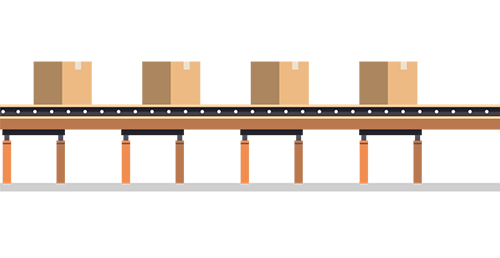Module 6 - Making it Happen
2. Tips for engaging with supplier
- Be polite and understand that as a small startup, you are probably not very important to them. Make sure you’ve done your homework and understand what you need from them. The more professional and credible you are, they more likely they are to take you seriously.
- Key aspects of your negotiation with suppliers will be around price, quality, availability and delivery times. Spend time ensuring that both sides have a clear understanding of what is expected and document this.
- When discussing pricing explore things like rebates. Can you get money back if you buy certain quantities?
- Understand how volume impacts availability and pricing.
- Remember to look for several suppliers and have a back-up when you’ve picked one.

Insourcing v outsourcing
When you’re creating a product or service, you’ll need to figure out whether you want to be in charge of manufacturing/development/delivery yourself or whether to outsource it. There are pros and cons to both.
| Pros | Cons | |
|---|---|---|
| Insourcing | • Greater control and flexibility to modify
processes enabling you to do things
that others can’t • Keep more of the “value add” associated with your supply chain • Authenticity | • Capital intensive • Management time spent on production/ delivery instead of R&D, marketing, sales, etc. • Underutilisation of assets/ limits to growth |
| Outsourcing | • Lower capital costs • Quicker timeframes (don’t have to set up facilities) • Benefit from other people’s expertise • Defined prices and potential to benefit from economies of scale | • Loss of control and oversight • Third parties less likely to care as much about the quality of your product as you. • Sharing information with third party of commercially sensitive information |
You will need to decide which of these factors are most important to your business and ultimately what will give you a competitive advantage. If components of your value proposition can be bought in, do you really need to make it yourself?
Insourcing: What insourcing entails will vary greatly from one business to another, so we can’t go into too much detail. Indeed, the requirements for setting up a food manufacturing plant are entirely different to bringing together a team of developers to make an app, or a team of scientists developing a new farming technique. However, you should consider the following:
- Capital expenditure plan: as noted above, insourcing is likely to be more capital intensive than outsourcing. It is especially important to spend time developing a robust capital expenditure plan (see Chapter 3 on business plan).
- Technical capacity: you will also need to make sure that you have the right technical capacity within the team to make this work.
- Scalability: determining what scale to develop operations to can be a challenge. A smaller setup will be quicker and cheaper to install but may quickly become redundant as you scale. Conversely a larger setup may be underutilised as you work to build up demand, eroding margins. Having confidence in your sales plan and financial forecast will help you make the right decision.

Outsourcing: Finding someone who can take over a substantial amount of your operations can seem like a silver bullet, but the work is far from over. Entrusting the delivery of a key part of your proposition to a third party has many challenges, and you’ll find plenty of entrepreneurs with very negative experiences of doing so. Still, here are some pointers if this is the path you choose to go down:

- Finding a third party to work with: Finding someone you can outsource to is not always straight forward. Speak with competitors as they may have spare capacity they need to use. Reach out to industry bodies as they might be able to refer you to a suitable party. Go to tradeshows. Speak with machine manufacturers as they may tell you who has purchased relevant equipment.
- Choosing a third party: There are many considerations to keep in mind including pricing, quality, lead times, how reactive they can be, what accreditations they hold and geographical location. You also want to consider their ability to meet increasing demand from you as you scale.
- Coming to an agreement: Make sure you have a clear agreement with them covering key aspects such as price, quality and lead-times. You will also want to think about protecting any IP you share with them. If there are setup costs, push for them to cover these. If that’s not possible, try and maintain ownership over anything you pay for. Make sure your agreement incentivises your partner to deliver a good product or service to you!
Insourcing & outsourcing case study

A company has developed indoor home vertical farming units that have become very popular. The company has been making the initial systems in a small rented workshop and are not able to keep up with demand. They also recognise that they could grow the market if they brought the unit cost down. This leads them to the conclusion that they need a more efficient setup to benefit from economies of scale. The founders identify a company that make similar systems for a different market but have spare capacity. At the same time, the founders do not have any experience in running a commercial production line and realise that setting up their own factory would take half a year. The move to outsourcing production simplifies their operations and gives them more clarity over their cost of goods. Freed from production oversight, they are able to spend more time on product development and sales. Given the importance of this arrangement to their business, they run trials and put in place a contract specifying key aspects including quality, lead times and who is responsible for investment in equipment specifically used for their production.
Packaging
In so many parts of the food system, packaging is an integral part of product elements. Food and packaging go hand in hand, you can’t really escape it (unless you’re developing a purely digital service). Packaging is important from a cost and environmental perspective and influences how your customers view your offering (even for B2B). Packaging is also increasingly scrutinised (particularly plastic) so it’s an important consideration when developing your commercial proposition.

You’ll need think about three key aspects:
- Functionality: what does your packaging need to do and how many different types of packaging do you need? In the food industry, packaging usually acts as a barrier for hygiene purposes and product preservation. If you’re developing a consumer facing product, you’ll also want to consider that packaging is your most important piece of marketing.
- Environmental impacts: you need to consider what the packaging is made of, how good it is at protecting the product and what your options are for the packaging after its useful life (e.g.: can it be reused or recycled?). You also have to consider packaging in the total environmental impact of a product. Wrapping a product in paper may have a lower environmental impact than a glass jar but if the product is spoiled by not being protected then the paper is not the more environmentally friendly choice. We’ve popped a few external links in the additional resources section of this chapter if you’d like to dig further into packaging.
- Cost: Your choice of packaging will impact costs in two ways. First, there is the direct cost of
packaging materials you are using. Second, your packaging choices will impact your production efficiency. For example, some packaging can be applied with a machine whereas others require a manual process. This will impact your costs and volumes you can produce.
Logistics
How you are going to store and distribute your products and services is not a very exciting part of your business so tends to be an after-thought, but your logistics have huge cost implications and may dictate which routes to market you can take. They’re thus worth a lot of consideration. Similarly to manufacturing and production, you should figure out if you want to keep this in-house or outsource it (working with warehousing and distribution companies). This again depends on the type of proposition you’re offering and how much control you want to keep over your business. Farmdrop, an online food delivery company that distributes foods to consumers that is sourced from local farmers and fishermen invested in its own fleet of electric vans and drivers as they see this service as part of their core proposition. Oddbox, an “ugly” fruit and vegetable box delivery company, on the other hand, has outsourced the delivery of their boxes to a third party as it is not crucial to their competitive advantage.
Trial runs and testing
As part of commercialising your product, you’ll inevitably have to do some trial runs. Doing things at scale is different to doing something at home and so you need to test how your offering will turn out when produced at greater volumes. This will also be helpful in confirming assumptions around the cost of production.
If you are doing trials with another company, agree what is expected of the trial and who will cover the costs beforehand. If the trials are done by a future supplier, try to get them to take on as much of the cost as possible. If they insist on payment, try and secure a discount against the first order.
The trial phase is also a good opportunity to test your product to ensure it meets safety requirements (see Chapter 4).
Entrepreneurs testimonials on commercialisation and scaling
“Focus on product management. It is easy to let things slip through the cracks when you’re going at 100 miles per hour and working on multiple things at once.”
-Arturo, Co-Founder at Clara Foods


“Prove a concept all the way to repeat purchases before you roll out/scale further”
-Willem Sodderland, Founder at Seamore

